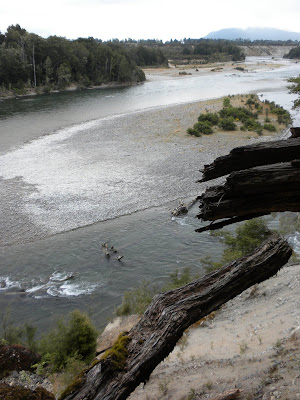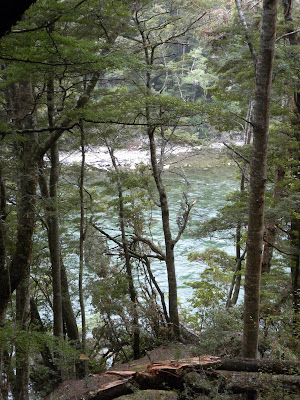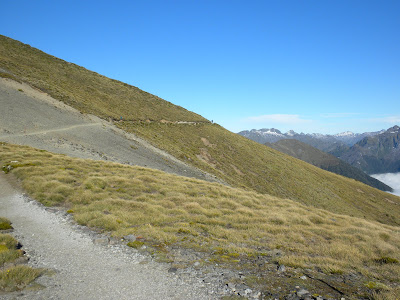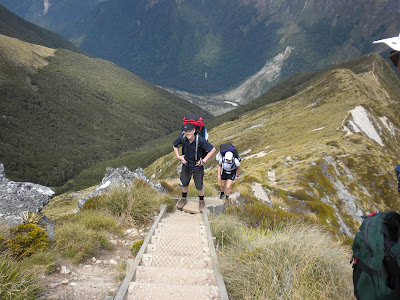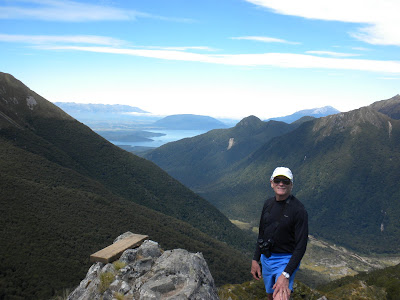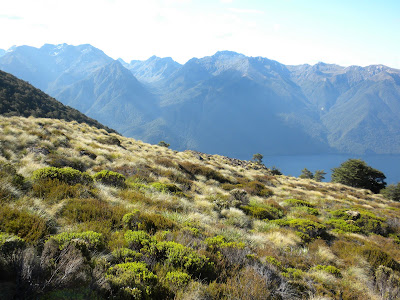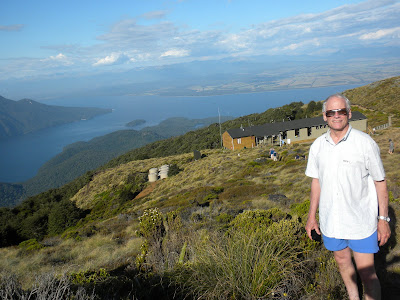
Wednesday, February 10, 2010
Kepler Track Day Four
On the morning of day four, they walked from Lake Manapouri to Lake Te Anau along the Waiau River, which connects the two lakes. Part of the walk goes by a peat bog that was created in the last ice age. At noon they got back to Lake Te Anau where they started, and they got back on the bus to drive 4 hours back to Dunedin.


Kepler Track Day Three
Day three was a six hour walk along the banks of the Iris Burn River. It's in a temperate rain forest, and the white stuff on the ground in the first two photos is lichen. Some of it looks a bit like the Olympic Rain Forest. It rains there more days than not, so it was amazing that they had perfect sunshine for the third day in a row.


Monday, February 8, 2010
Kepler Track Day Two
When they got up on Friday morning, they found that the valley with Lake Te Anau in it was full of clouds, but they were above the clouds in the sunshine. About half of the second day of the Kepler is up high on ridges. Then the second half of the day is the steep walk down. Most of the photos Dave took are from the high walk along the ridges.




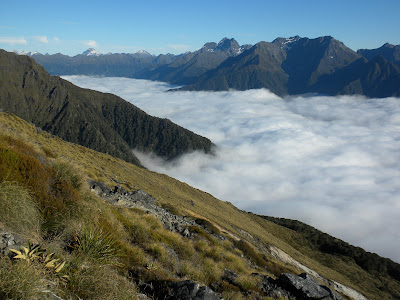


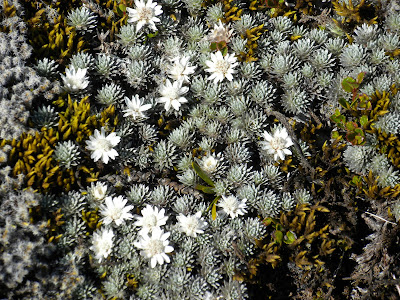
 The next photo looks back on the route they've been walking. The highest peak in the far distance is Mount Luxmore.
The next photo looks back on the route they've been walking. The highest peak in the far distance is Mount Luxmore.


 After several hours of walking, they came to the downhill section. There were several series of steps. The people coming up the steps in the next photo are walking the Kepler in the opposite direction, so they were coming up. You can see the river far below. That's where the hut for the second night was, so they had to walk all the way down to it.
After several hours of walking, they came to the downhill section. There were several series of steps. The people coming up the steps in the next photo are walking the Kepler in the opposite direction, so they were coming up. You can see the river far below. That's where the hut for the second night was, so they had to walk all the way down to it.






The daisies in the the next photo are called Mountain Daisies. They have stiff leaves like a succulent plant, and they are the iconic flower of the Kepler Track.


 The next photo looks back on the route they've been walking. The highest peak in the far distance is Mount Luxmore.
The next photo looks back on the route they've been walking. The highest peak in the far distance is Mount Luxmore.

 After several hours of walking, they came to the downhill section. There were several series of steps. The people coming up the steps in the next photo are walking the Kepler in the opposite direction, so they were coming up. You can see the river far below. That's where the hut for the second night was, so they had to walk all the way down to it.
After several hours of walking, they came to the downhill section. There were several series of steps. The people coming up the steps in the next photo are walking the Kepler in the opposite direction, so they were coming up. You can see the river far below. That's where the hut for the second night was, so they had to walk all the way down to it.Kepler Track Day One
Last Wednesday, Dave left Dunedin on a bus with a Rotary Club group to walk the Kepler track, one of New Zealand's "Great Walks." I would call it a serious hike, not a walk: 67 km (41 miles) in three and a half days, with a vertical rise up (mostly in the first day) and down (mostly in the second day) of somewhere around 1000 meters. The Department of Conservation has "huts" where the hikers sleep on bunk beds with foam mattresses, but they carry in their food and sleeping bags. They rode a bus four hours to get to Te Anau, spent the night there in relative comfort, then walked about six hours on Thursday. The walk began with about an hour and a half along the lakeshore of Lake Te Anau, then up hill through bush (woods) for a while, then uphill above the tree line for the rest of the way. Here's a map that shows the track in red:

 Below is the view back on Te Anau from the uphill part of the track that is still in the woods.
Below is the view back on Te Anau from the uphill part of the track that is still in the woods.

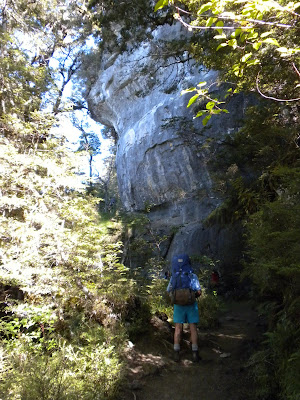 After the big rock face in the photo above, they finally got above the tree line.
After the big rock face in the photo above, they finally got above the tree line.
 In the photo below, that highest point in the distance is Mount Luxmore, and the hut for the first night is located on the flanks of that mountain. The photo below was taken about 3 hours into the hike.
In the photo below, that highest point in the distance is Mount Luxmore, and the hut for the first night is located on the flanks of that mountain. The photo below was taken about 3 hours into the hike.
 The photos below show Lake Te Anau in the distance. That's where they started.
The photos below show Lake Te Anau in the distance. That's where they started.

 The grasses in the photo below are called tussock, and tussock is common on the hills all over the South Island.
The grasses in the photo below are called tussock, and tussock is common on the hills all over the South Island.
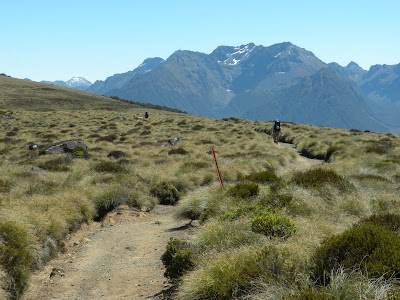 I thought "walk" was the wrong word to describe this hike, and I think "hut" is the wrong word to describe the building where they slept. The hut sleeps 40 and has LPG for cooking (which is helicoptered in) and solar lights that worked for about two hours after sunset. They got up in the dark and had no light in the morning. These huts are reserved months or even a year in advance.
I thought "walk" was the wrong word to describe this hike, and I think "hut" is the wrong word to describe the building where they slept. The hut sleeps 40 and has LPG for cooking (which is helicoptered in) and solar lights that worked for about two hours after sunset. They got up in the dark and had no light in the morning. These huts are reserved months or even a year in advance.

 Below is the view back on Te Anau from the uphill part of the track that is still in the woods.
Below is the view back on Te Anau from the uphill part of the track that is still in the woods.
 After the big rock face in the photo above, they finally got above the tree line.
After the big rock face in the photo above, they finally got above the tree line. In the photo below, that highest point in the distance is Mount Luxmore, and the hut for the first night is located on the flanks of that mountain. The photo below was taken about 3 hours into the hike.
In the photo below, that highest point in the distance is Mount Luxmore, and the hut for the first night is located on the flanks of that mountain. The photo below was taken about 3 hours into the hike. The photos below show Lake Te Anau in the distance. That's where they started.
The photos below show Lake Te Anau in the distance. That's where they started.
 The grasses in the photo below are called tussock, and tussock is common on the hills all over the South Island.
The grasses in the photo below are called tussock, and tussock is common on the hills all over the South Island. I thought "walk" was the wrong word to describe this hike, and I think "hut" is the wrong word to describe the building where they slept. The hut sleeps 40 and has LPG for cooking (which is helicoptered in) and solar lights that worked for about two hours after sunset. They got up in the dark and had no light in the morning. These huts are reserved months or even a year in advance.
I thought "walk" was the wrong word to describe this hike, and I think "hut" is the wrong word to describe the building where they slept. The hut sleeps 40 and has LPG for cooking (which is helicoptered in) and solar lights that worked for about two hours after sunset. They got up in the dark and had no light in the morning. These huts are reserved months or even a year in advance.
Subscribe to:
Posts (Atom)




